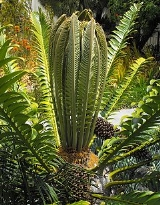
Encephalartos transvenosus
Encyclopedia
Encephalartos transvenosus (Modjadji Cycad or Modjadji's Cycad) is a palm
-like cycad
in the family Zamiaceae
. It is found in Limpopo Province in South Africa
. It is also sometimes called "Modjadji's palm" and is named after the Rain Queen
. The species name transvenosus refers to the fine network of veins between the main veins. These can be seen when the leaf is held up to the light.
Arecaceae
Arecaceae or Palmae , are a family of flowering plants, the only family in the monocot order Arecales. There are roughly 202 currently known genera with around 2600 species, most of which are restricted to tropical, subtropical, and warm temperate climates...
-like cycad
Cycad
Cycads are seed plants typically characterized by a stout and woody trunk with a crown of large, hard and stiff, evergreen leaves. They usually have pinnate leaves. The individual plants are either all male or all female . Cycads vary in size from having a trunk that is only a few centimeters...
in the family Zamiaceae
Zamiaceae
The Zamiaceae are a family of cycads that are superficially palm or fern-like. They are divided into two subfamilies with eight genera and about 150 species in the tropical and warm temperate regions of Africa, Australia and North and South America....
. It is found in Limpopo Province in South Africa
South Africa
The Republic of South Africa is a country in southern Africa. Located at the southern tip of Africa, it is divided into nine provinces, with of coastline on the Atlantic and Indian oceans...
. It is also sometimes called "Modjadji's palm" and is named after the Rain Queen
Rain Queen
The Modjadji or Rain Queen is the hereditary queen of Balobedu, a people of the Limpopo Province of South Africa. The succession to the position of Rain Queen is matrilineal, meaning that the Queen's eldest daughter is the heir, and that males are not entitled to inherit the throne at all...
. The species name transvenosus refers to the fine network of veins between the main veins. These can be seen when the leaf is held up to the light.

